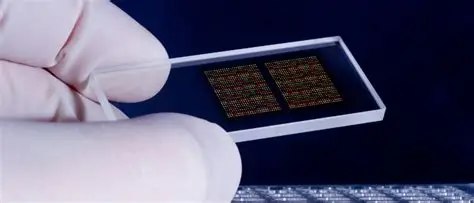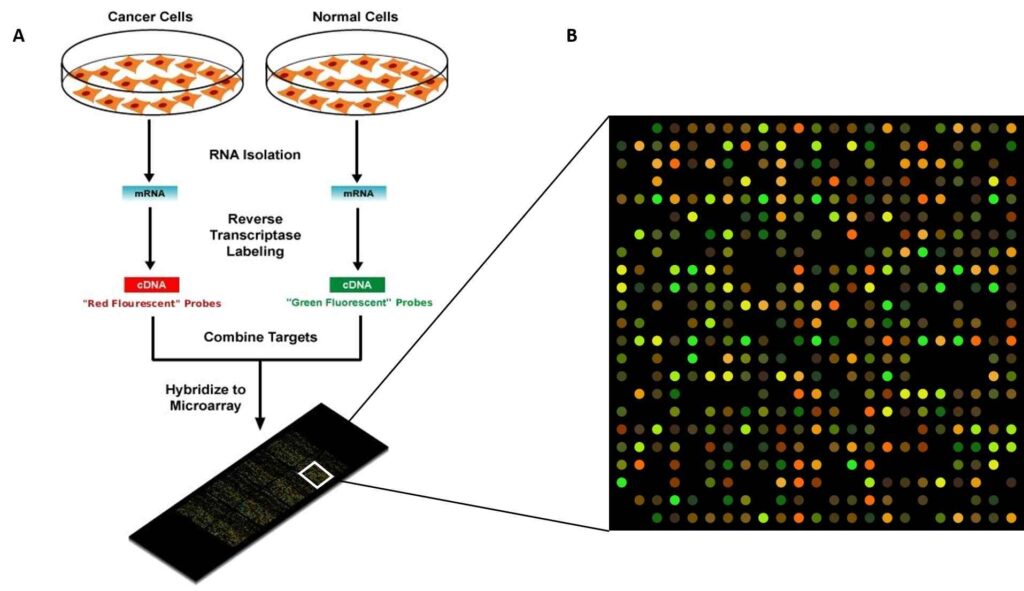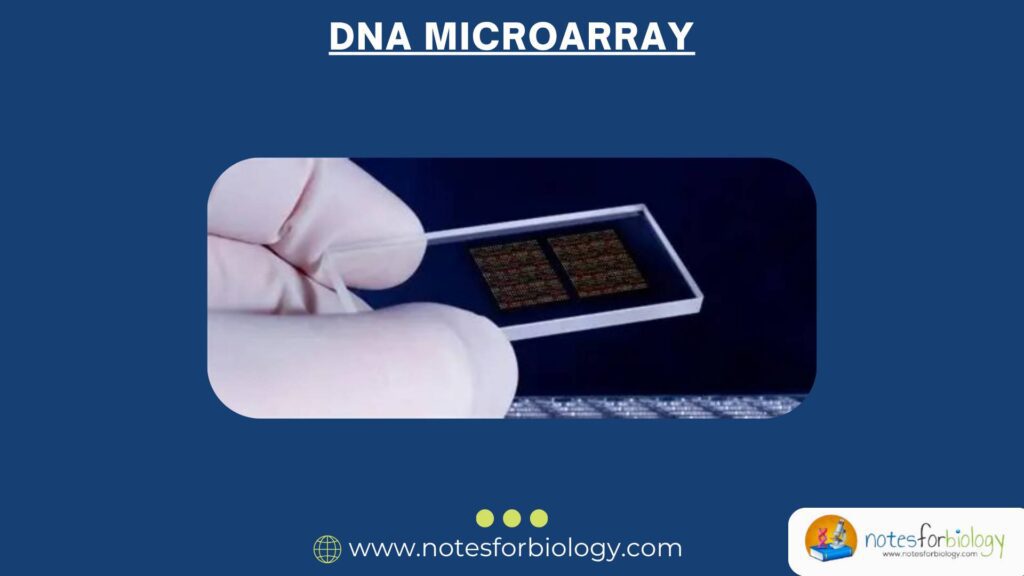Introduction
Imagine if you could look at the activity of thousands of genes all at once, just like scanning the entire library to see which books are being read at the same time. This is exactly what a DNA microarray allows scientists to do. DNA microarray technology is a powerful tool in molecular biology that helps us understand gene expression the process by which genes are turned on or off in a cell.
Used widely in genetics, medicine, cancer research, and biotechnology, DNA microarrays offer a window into the genetic workings of cells. They allow scientists to examine the expression patterns of thousands of genes in a single experiment, helping identify which genes are active, inactive, or abnormally regulated.

This document aims to explain DNA microarrays in the most simple, clear, and humanized way, covering the definition, principle, step-by-step procedure, types, and real-world importance of this transformative technology.
Table of Contents
Definition
A DNA microarray is a laboratory tool used to detect the expression of thousands of genes at the same time. It consists of a small solid surface, usually a glass slide or silicon chip, onto which DNA fragments (probes) are fixed in an orderly grid or array.

These probes represent specific genes. When labeled sample DNA or RNA is applied to the chip, it binds or hybridizes with complementary DNA sequences. This interaction is detected using fluorescent signals, and the data reveals which genes are active in a given sample.
In simple terms, a DNA microarray is like a mini-lab on a slide that can check thousands of genes simultaneously to find out which are turned on or off in a biological sample.
Principle
The working principle of DNA microarray technology is complementary base pairing or hybridization. Here’s how it works:
- Every gene has a unique DNA sequence.
- Short fragments of these sequences (called probes) are fixed on a chip in tiny spots.
- A sample of labeled cDNA (made from mRNA) is washed over the chip.
- The cDNA binds or hybridizes with its matching DNA probe.
- Each spot where hybridization occurs emits a fluorescent signal.
- The intensity of fluorescence shows how much of that gene was expressed in the sample.
So, if a gene is highly active, more mRNA is made, leading to more labeled cDNA binding to the probe and a brighter signal. If a gene is inactive, there is no signal.
Key Concepts Behind the Principle:
- Hybridization: Binding of complementary DNA/RNA strands.
- Fluorescent labeling: Allows visualization of bound DNA.
- Parallel processing: Thousands of genes can be analyzed in a single run.
- Quantification: Fluorescence intensity correlates with gene expression level.
Components
Understanding what makes up a DNA microarray helps grasp how the system works.
1. Solid Surface (Slide or Chip)
Usually made of glass, nylon, or silicon, it provides the base to hold thousands of DNA spots.
2. DNA Probes
Short single-stranded DNA sequences representing specific genes. These are fixed onto the chip at precise locations.
3. Sample (Target) DNA or RNA
Typically mRNA extracted from cells is converted into complementary DNA (cDNA), which is labeled with fluorescent dyes.
4. Fluorescent Labels
Dyes like Cy3 (green) and Cy5 (red) are commonly used to distinguish between two samples in comparative studies.
5. Scanner
A laser-based scanner detects the fluorescent signals and sends the data to software for analysis.
6. Bioinformatics Software
This analyzes the fluorescence data and generates visual maps or heatmaps indicating gene activity.
Procedure
Now let’s break down the entire into simple, understandable steps.
Step 1: Sample Preparation
First, cells or tissues are collected, and RNA is extracted since gene expression is measured by RNA production. RNA is the immediate product of active genes.
Step 2: cDNA Synthesis and Labeling
The extracted mRNA is converted into complementary DNA (cDNA) using reverse transcriptase enzyme. During this step, fluorescent dyes (Cy3, Cy5) are incorporated into the cDNA. For comparative studies:
- One sample is labeled with Cy3 (green)
- Another with Cy5 (red)
Step 3: Hybridization
The labeled cDNA samples are mixed and applied to the DNA microarray chip. The samples hybridize (bind) to the complementary DNA probes on the chip. Each spot on the array binds to its matching gene segment.
Step 4: Washing
Unbound or non-specifically bound cDNA is washed off the chip to reduce background noise and ensure accurate results.
Step 5: Scanning
The chip is scanned using a laser scanner that detects the fluorescent signals. Each spot emits light depending on how much labeled cDNA is bound to it.
Step 6: Data Analysis
The scanner sends the data to specialized software that:
- Measures fluorescence intensity
- Compares gene expression levels
- Displays results as colored images or graphs
- Red spots: Gene highly expressed in sample 1
- Green spots: Gene highly expressed in sample 2
- Yellow spots: Gene equally expressed in both samples
- Black spots: Gene not expressed in either sample
Step 7: Interpretation
Researchers analyze the patterns to:
- Identify genes involved in diseases
- Compare healthy vs diseased tissues
- Track changes in gene expression over time or in response to drugs
Types
There are various types based on their construction and purpose. Here are the most common ones:
1. cDNA
Definition:
Uses full-length or partial complementary DNA sequences as probes.

Features:
- Older type of array
- Usually printed using robotic spotters
- Cheaper but less specific
Used For:
- Comparing gene expression in different conditions
- Studying cancer vs normal tissues
2. Oligonucleotide Microarrays
Definition:
Use short DNA sequences (20–70 base pairs) as probes.
Features:
- Highly specific and sensitive
- Commercially synthesized on chips
Used For:
- High-resolution gene expression profiling
- Mutation analysis
- Genotyping
Example:
Affymetrix GeneChip is a famous oligonucleotide microarray.
3. SNP Microarrays
Definition:
Designed to detect single nucleotide polymorphisms (SNPs)—small genetic variations in the DNA sequence.
Features:
- Helps in studying genetic predisposition to diseases
- Used in population genetics and personalized medicine
Used For:
- Genome-wide association studies (GWAS)
- Personalized drug response prediction
4. Tiling Arrays
Definition:
Covers the entire genome or large regions with overlapping probes.
Features:
- Offers a comprehensive look at genomic regions
- Detects unknown transcripts, exons, or regulatory elements
Used For:
- Whole genome expression profiling
- Mapping transcription factor binding sites
5. Protein Microarrays
Although not DNA-based, protein microarrays are worth mentioning as they work on similar principles to analyze proteins instead of genes.
Used For:
- Antibody-antigen interactions
- Drug screening
- Protein function studies
Applications
It has revolutionized many areas of biology and medicine.
1. Disease Diagnosis
It can identify which genes are abnormally expressed in diseases like cancer, heart disease, or diabetes.
Example:
Microarrays help classify types of leukemia based on gene expression patterns, aiding diagnosis and treatment.
2. Cancer Research
By comparing gene activity in cancerous and normal tissues, it helps identify oncogenes (cancer-causing genes) and tumor suppressor genes.
3. Drug Discovery and Development
Microarrays allow testing how drugs affect gene expression. This helps in:
- Identifying drug targets
- Predicting drug responses
- Screening potential side effects
4. Personalized Medicine
Gene expression profiles from patients can guide doctors in choosing the most effective drugs or treatments.
Example:
Breast cancer patients with specific gene signatures may benefit from certain chemotherapy drugs, while others may not.
5. Genotyping and SNP Detection
DNA microarrays detect single base changes in DNA, helping identify genetic traits, ancestry, or disease risks.
6. Microbial Identification
Microarrays can quickly identify bacteria or viruses by detecting their unique DNA sequences.
7. Agricultural Biotechnology
Used to study gene expression in plants under stress (drought, salinity) or improve crop yield through genetic analysis.
8. Stem Cell and Developmental Biology
By tracking which genes turn on or off during development, microarrays help understand how cells differentiate and form tissues.
Advantages of DNA Microarrays
- Allows simultaneous analysis of thousands of genes
- Requires small amounts of sample
- High sensitivity and specificity
- Provides quantitative and qualitative gene expression data
- Useful in clinical, research, and industrial applications
Limitations of DNA Microarrays
- Cannot detect unknown sequences
- Results can be influenced by sample quality
- Needs complex equipment and trained personnel
- Lower accuracy compared to RNA sequencing (RNA-Seq)
- May not detect low-abundance genes reliably
DNA Microarray vs RNA Sequencing
| Feature | DNA Microarray | RNA Sequencing |
|---|---|---|
| Cost | Generally cheaper | More expensive |
| Sensitivity | Moderate | Very high |
| Scope | Limited to known genes | Can detect unknown transcripts |
| Data Volume | Moderate | Very high |
| Customization | Pre-designed probes | No need for probes |
Recent Advances and Future of Microarrays
Though RNA sequencing is gaining popularity, DNA microarrays are still evolving. Recent advances include:
- High-density chips with more genes
- Portable microarrays for field testing
- Automated hybridization systems
- Microfluidic lab-on-a-chip devices
Future trends may integrate microarrays with:
- Artificial intelligence for predictive diagnostics
- Wearable biosensors
- Point-of-care genetic testing kits
Conclusion
DNA microarrays are one of the most powerful and versatile tools in molecular biology. They provide a high-throughput, efficient, and cost-effective way to analyze gene expression patterns across thousands of genes at once. This allows researchers to gain insights into complex biological processes, understand the molecular basis of diseases, and develop more precise treatments.
With continuous improvements in accuracy, data analysis, and affordability, DNA microarrays will continue to play a crucial role in medicine, agriculture, research, and biotechnology. Understanding their principle, types, and procedure equips anyone in the life sciences with the knowledge to explore the world of gene expression like never before.
Three Key Summary
- DNA microarrays detect gene expression by measuring the hybridization between known DNA probes and sample cDNA, using fluorescence.
- There are different types of microarrays—cDNA, oligonucleotide, SNP, and tiling arrays—each suited for specific applications.
- DNA microarrays are used widely in disease diagnosis, cancer research, personalized medicine, drug development, and genetic studies.
FREQUENTLY ASKED QUESTIONS
What is the difference between DNA microarray and PCR?
PCR amplifies specific DNA sequences, while DNA microarrays analyze the expression of thousands of genes at once through hybridization
Can DNA microarrays detect mutations?
Yes. Specialized arrays like SNP arrays can detect single base changes or mutations in the genome.
Are DNA microarrays still used today?
Yes. While RNA sequencing is rising, DNA microarrays remain widely used in research, diagnostics, and education due to their affordability and simplicity.
Related Articles




